Tooth of the Lion

By Barry Glick
When my esteemed editor, Joshua Baldwin, told me that “this is a food issue, what can you come up with?” I immediately sought out my tattered copy of Stalking The Wild Asparagus to jog my memories of hunting for wild edibles. This bible of wild foods was written in 1962 by Euell Gibbons, one of my early heroes upon moving to West Virginia from the streets of Philadelphia. You can still find used copies on Amazon for a fiver or less. What a bargain!
While my hope is that none of my dear readers will ever lose their way in the woods on their way to grandma’s house, you need not worry about starving to death. I’m sure you’ve all heard tales about eating lichens, and I can tell you from personal experience, that they’re really not that yummy. You can, though, pretty much count on them for navigational purposes as what you’ve been told all these years is mostly true, they do primarily grow on the north side of trees. There are some exceptions, but we’ll chat about that another time.
So let’s just assume for a moment that you’re not really lost in the woods, but you are interested in uncultivated, wild food plants. We can begin the discussion on your lawn with the Taraxacum officinale that you curse every spring. Yes, one of the reasons that “Dandelions” are so good for you to eat, is the same reason that they aren’t that good for your lawn. Dandelions are loaded with minerals and vitamins and while some are manufactured in the plant from the environment, many are taken up from the soil, like copper and selenium. If your lawn isn’t very fertile to begin with, well, you can imagine what happens.
Like many other plants in our part of the world, Dandelions, a Eurasian native, are not native to our continent, but were brought here by the early settlers for a multitude of reasons, culinary and medicinal. Other plants in this genre include “Coltsfoot,” “Mullein,” and “Chicory” to name a few. Since they didn’t evolve here with nature’s normal checks and balances, they’ve become very aggressive and OK, let’s use the “W” word—weedy.
Before we go much further, permit me to shed some light on the meaning of the “catchy” subject line of this here article. It’s really quite simple, in Latin and in French, “Dent” or “Dente” means “tooth,” “lion” in Latin is “Leo” and in French is “Lion.” Don’t ask me why it’s supposed to be capitalized in French! Of course we all know that “of” is “de” or “di” in most all the romantic languages. So there you have it—Dent De Lion, now say it smooth and fast–Dandelion! This obviously came to pass when someone back in the days of yore thought the foliage resembled a Lion’s tooth.
Now back to the important stuff; health, food and nutrition. A cup of raw Dandelion greens contains over 500% of your RDA of Vitamin K, over 100% of your RDA of Vitamin A, 32% Vitamin C, measurable amounts of Potassium, Iron, Calcium, Magnesium and the list goes on and on. If you’re going to eat this raw in your salad, get the tiniest young leaves that you can find.
Dandelion tea has been used for centuries and by many cultures medicinally. A tea made from the roots has potent diuretic properties and is purported to have robust detoxifying powers to cleanse your liver in addition to being a recognized antioxidant.
Now, I don’t want to lead you astray and have you think that Dandelions are the most palatable wild veggie you’ll encounter. Although the tender young leaves seem to lack the bitter principle that intensifies as the growing season progresses, the larger, older leaves can be quite bitter. So at this point, you may want to treat them as spinach and boil them. If the foliage is really old, two boilings may be called for. Not to worry about cooking away any nutritive benefits, as heat doesn’t affect them. After draining, just smother the greens with olive oil, garlic and a dusting of toasted sesame seeds. Totally delish! Oh, and don’t throw away the liquid, as it retains plenty of minerals and vitamins.
And appreciate the flowers as they make a tasty appetizer. Just pick the blooms when they first open, dip them in batter and pan fry them in olive or peanut oil. Mmmmmmmmmmm.
I’d be remiss if I didn’t mention Dandelion Wine, it’s pretty easy to make your own and you can find several recipes on line. Even the wine has the health benefits of this remarkable plant.
You may think it a tad silly that I suggest you buy Dandelion seeds to plant in your garden when the plant is so prevalent, but there are cultivated varieties available that have been bred and selected to have less of the bitter principle. You can buy seeds of an Italian variety named ‘Catalogna Special’ from Johnny’s Seeds on line and even Burpee’s has a variety for sale. I’m not sure if selecting and breeding compromises the nutritional components of the wild plant, so I’m sticking with the ones in my yard.
If you really want a quick fix of this special plant, and you don’t want to start digging your lawn up in the middle of the winter, our local Kroger store in Fairlea has organic dandelion greens for sale almost all the time. If you’re embarrassed to be seen by your neighbors buying Dandelions, the store is pretty empty just before closing at midnight, so there’s less chance of being spotted.
If all this weren’t enough for you to embrace a whole new outlook about dandelions, as if you didn’t already know, Greenbrier County, and White Sulphur Springs to be specific, is home to the world famous WV Dandelion Festival, offering three days of music, fun, food and entertainment of all kinds. Dates this year are May 27-29 and you can visit wvdandelionfestival.com to get the whole schedule.
We’ve barely skimmed the surface here in this limited space. I could fill pages of this magazine about fun projects such as roasting the roots and making a coffee like beverage, using the sap as a skin treatment for acne, dandelions’ ability to treat a myriad of ailments, etc. However at this point, I should evoke the “Don’t try this at home kids” disclaimer—be careful before trying ANYTHING new, do your homework and think about your current health situation. For example, as I mention above, dandelions have over 500% of your RDA of vitamin K. If you’re on blood thinners, this may pose a problem. Better to be safe than sorry.
So, to paraphrase all of the ridiculous drug commercials on TV, if you have any health concerns, “Ask Your Doctor If Dandelions Are Right For You.”
Till our next Horticultural Escapade together,
Peace out,
Glickster




